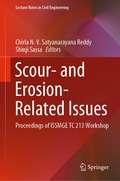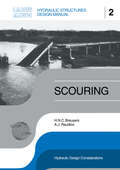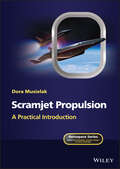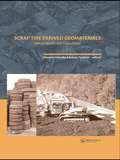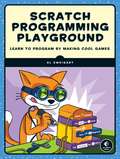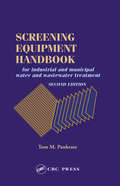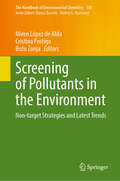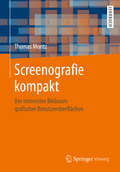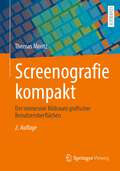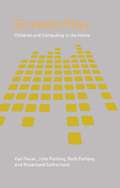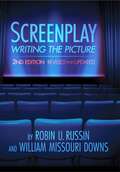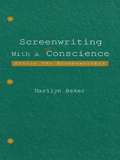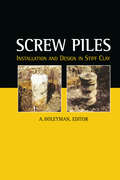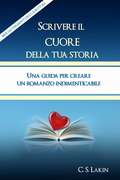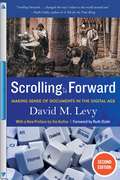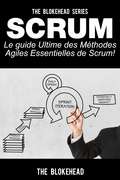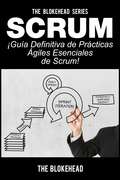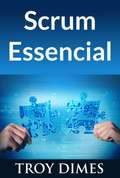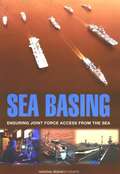- Table View
- List View
Scour- and Erosion-Related Issues: Proceedings of ISSMGE TC 213 Workshop (Lecture Notes in Civil Engineering #177)
by Shinji Sassa Chirla N. V. Satyanarayana ReddyThis book comprises chapters on scour and erosion related issues. It is an outcome of the International Society for Soil Mechanics and Geotechnical Engineering (ISSMGE) Technical Committee 213 Workshop on Scour and Erosion that was held on December 16, 2020. The ISSMGE TC213 Workshop was attended by 368 participants from 12 different countries worldwide. The contents of this book reflect recent advances in the mechanics and countermeasures of scour and erosion, including coastal protection, erosion control, etc. Covering practical issues of geotechnical engineering with academic and research inputs, this volume will be a useful reference for academia and industry alike.
Scouring: Hydraulic Structures Design Manual Series, Vol. 2 (Iahr Design Manual Ser. #2)
by H.N.C. Breusers A.J. RaudkiviInformation and technical data concerning scouring/erosion caused by water fl in rivers and streams. More specifically, how certain structures exaggerate this natural process by restricting water flow, causing constriction and loc scour. Material presented is from both field studies and laboratories
Scramjet Propulsion: A Practical Introduction (Aerospace Series)
by Dora MusielakScramjet Propulsion Explore the cutting edge of HAP technologies with this comprehensive resource from an international leader in her field Scramjet Propulsion: A Practical Introduction delivers a comprehensive treatment of hypersonic air breathing propulsion and its applications. The book covers the most up-to-date hypersonic technologies, like endothermic fuels, fuel injection and flameholding systems, high temperature materials, and TPS, and offers technological overviews of hypersonic flight platforms like the X-43A, X-51A, and HiFIRE. It is organized around easy-to-understand explanations of technical challenges and provides extensive references for the information contained within. The highly accomplished author provides readers with a fulsome description of the theoretical underpinnings of hypersonic technologies, as well as critical design and technology issues affecting hypersonic air breathing propulsion technologies. The book’s combination of introductory theory and advanced instruction about individual hypersonic engine components is ideal for students and practitioners in fields as diverse as hypersonic vehicle and propulsion development for missile defense technologies, launch aerospaceplanes, and civilian transports. Over 250 illustrations and tables round out the material. Readers will also learn from: A thorough introduction to hypersonic flight, hypersonic vehicle concepts, and a review of fundamental principles in hypersonic air breathing propulsion Explorations of the aerothermodynamics of scramjet engines and the design of scramjet components, as well as hypersonic air breathing propulsion combustors and fuels Analyses of dual-mode combustion phenomena, materials structures, and thermal management in hypersonic vehicles, and combined cycle propulsion An examination of CFD analysis, ground and flight testing, and simulation Perfect for researchers and graduate students in aerospace engineering, Scramjet Propulsion: A Practical Introduction is also an indispensable addition to the libraries of engineers working on hypersonic vehicle development seeking a state-of-the-art resource in one of the most potentially disruptive areas of aerospace research today.
Scrap Tire Derived Geomaterials - Opportunities and Challenges: Proceedings of the International Workshop IW-TDGM 2007 (Yokosuka, Japan, 23-24 March 2007)
by Hemanta Hazarika Kazuya YasuharaSCRAP TIRE DERIVED GEOMATERIALS is a compilation of peer-reviewed papers presented at the International Workshop on Scrap Tire Derived Geomaterials (IW-TDGM 2007) in Yokosuka, Japan in March 2007.The workshop was the first ever international forum on scrap tire derived geomaterials (TDGM), bringing together people from various disciplines working i
Scratch Programming Playground: Learn to Program by Making Cool Games
by Al SweigartScratch, the colorful drag-and-drop programming language, is used by millions of first-time learners, and in Scratch Programming Playground, you’ll learn to program by making cool games. Get ready to destroy asteroids, shoot hoops, and slice and dice fruit!Each game includes easy-to-follow instructions, review questions, and creative coding challenges to make the game your own. Want to add more levels or a cheat code? No problem, just write some code.You’ll learn to make games like:–Maze Runner: escape the maze!–Snaaaaaake: gobble apples and avoid your own tail–Asteroid Breaker: smash space rocks–Fruit Slicer: a Fruit Ninja clone–Brick Breaker: a remake of Breakout, the brick-breaking classic–Platformer: a game inspired by Super Mario Bros.Learning how to program shouldn’t be dry and dreary. With Scratch Programming Playground, you’ll make a game of it!Uses Scratch 2
Scratchmanía
by Raúl Lapeira¡Scratch, la programación al alcance de los más pequeños, de la mano de los máximos expertos en España! Scratch es el lenguaje de programación visual más sencillo con el que los niños podrán dar sus primeros pasos sin tener un conocimiento profundo de código. El libro combina la teoría y explicación sobre lo que es el scratch, a la vez que plantea proyectos sencillos para llevar a cabo utilizando la herramienta que se ha estudiado en un comienzo.
Scream Machines (Fountas & Pinnell LLI Gold #Level T)
by Laura Johnsoncream Machines Author: Laura T. Johnson
Screening Equipment Handbook
by Thomas M. PankratzThis updated second edition summarizes screening equipment options available for industrial and municipal water and wastewater treatment. It provides a consolidated source of basic design and application to assist engineers in selecting a screen best suited for the particular application.
Screening of Pollutants in the Environment: Non-target Strategies and Latest Trends (The Handbook of Environmental Chemistry #138)
by Miren López de Alda Cristina Postigo Božo ŽonjaThis book reviews the latest advances in mass spectrometry for detecting environmental pollutants. With high-resolution mass spectrometry instruments becoming more accessible in research labs, scientists can now expand their analytical capabilities, establishing non-target strategies to identify priority pollutants and uncover new potentially hazardous compounds in various environmental compartments.In this book, readers will find a range of critical topics, including the use of ion mobility as a third dimension for compound confirmation in environmental samples, and the integration of high-resolution mass spectrometry analysis with market data to prioritize environmental contaminants. The book also explores effect-directed methods combined with non-target screening for identifying toxic transformation products, and the combination of passive sampling with non-target analysis for comprehensive environmental assessments. Additionally, it covers screening strategies for disinfection byproducts in drinking water and the human chemical exposome, providing insights into the quantitation of non-target data and the discovery of transformation byproducts of emerging contaminants.Given its breadth, this book is an essential resource for scientists addressing environmental pollution, students and academics in environmental analytical chemistry, and researchers focused on water, soil, and air studies. Environmental managers and engineers designing novel pollution remediation systems will find innovative strategies to advance their work. By focusing on priority pollutants and novel screening strategies, this book equips readers with the knowledge to tackle pressing environmental challenges.
Screenografie kompakt: Der immersive Bildraum grafischer Benutzeroberflächen
by Thomas MoritzDieses Buch behandelt die Screenografie von grafischen Benutzeroberflächen basierend auf einem didaktisch strukturierten Lehrprogramm, dessen Kapitel inhaltlich aufeinander aufbauen und jeweils in einem zusammenfassenden Fazit enden. Nach einer einführenden thematischen Motivation werden wahrnehmungspsychologische und kommunikationswissenschaftliche Grundlagen des Systemischen Designs erläutert, dessen Spezifik für die systematische Entwicklung grafischer Benutzeroberflächen essentiell ist. Im Kontext immersiver Raumnutzung wird u.a. illustriert, wie ein Screen morphologisch in kleinere geometrische Einheiten unterteilbar ist, die als visuelles Ganzes die ideale Basis für ein visuelles Gestaltungsraster bilden, welches den immersiven Bildraum strukturiert und organisiert. Es werden nutzerspezifische Farbgebungen für ein visuelles Ambiente aufgezeigt, das einem speziellen Nutzernaturell entspricht, da es auf Erfahrungen mit natürlichen Umgebungen basiert und über alle geografischen und ethnologischen Grenzen hinweg stimuliert und zur interaktiven Nutzung motiviert.
Screenografie kompakt: Der immersive Bildraum grafischer Benutzeroberflächen
by Thomas MoritzDieses Lehrprogramm zur systematischen Gestaltung eines interaktiv nutzbaren Bildschirms (Screen) erläutert wahrnehmungspsychologische und kommunikationswissenschaftliche Grundlagen, die für das Systemische Design grafischer Benutzeroberflächen (Graphical User Interfaces) relevant sind. Im Kontext interaktiver Raumnutzung wird illustriert, wie die Bildschirmfläche morphologisch in Form eines visuellen Gestaltungsrasters (Visual Design Pattern) zu gliedern ist, das den immersiven Bildraum der grafischen Benutzeroberfläche strukturiert und die interaktive Nutzung erleichtert. Es werden mögliche Farbkombinationen für ein visuelles Ambiente definiert, deren Wirkungsweise auf natürlichen Erfahrungswerten basiert und somit einem speziellen Nutzernaturell entspricht, dessen Charakteristika weltweit identisch sind.
Screenografie kompakt: Der immersive Bildraum grafischer Benutzeroberflächen
by Thomas MoritzDieses Lehrprogramm zur systematischen Gestaltung eines interaktiv nutzbaren Bildschirms (Screen) erläutert wahrnehmungspsychologische und kommunikationswissenschaftliche Grundlagen, die für das Systemische Design grafischer Benutzeroberflächen (Graphical User Interfaces) relevant sind. Im Kontext interaktiver Raumnutzung wird illustriert, wie die Bildschirmfläche morphologisch in Form eines visuellen Gestaltungsrasters (Visual Design Pattern) zu gliedern ist, das den immersiven Bildraum der grafischen Benutzeroberfläche strukturiert und die interaktive Nutzung erleichtert. Es werden mögliche Farbkombinationen für ein visuelles Ambiente definiert, deren Wirkungsweise auf natürlichen Erfahrungswerten basiert und somit einem speziellen Nutzernaturell entspricht, dessen Charakteristika weltweit identisch sind. In der dritten Auflage wird der historische Kontext im Aufbau visueller Gestaltungsraster analysiert. Die Abkehr vom realistisch gemalten Tafelbild ermöglichte neue Formensprachen und Kunstformen auf Grundlage der systematischen Konstruktion analog der Gestaltungslehre des Bauhauses. Die tragende Rolle von Mathematik und Geometrie im künstlerischen Schaffensprozess „Konkreter Kunst&“ wird durch zahlreiche Beispiele illustriert und um beispielhafte Gestaltungslösungen aus dem Bereich des "Absoluten Films" ergänzt.
Screenplay: Children and Computing in the Home
by John Furlong Rosamund Sutherland Keri Facer Ruth FurlongWhat are young people really doing on computers at home?Computers feature heavily in the lives of today's young people, and this book sets out to question commonplace assumptions about the use of technology by children at home. Bringing together research from the perspective of psychology, sociology, education and media studies, the authors ask whether we are really witnessing the rise of a new 'digital generation'.Drawing upon the results of their in-depth research project, the authors filter and assess their findings accessibly, offering fascinating reading on:* how computers are used in the home* how parents and children negotiate access to and use of the computer* what role the computer plays in the day to day lives of families.This book makes use of illuminating case studies, and highlights key issues of concern around issues of equality and access in a wider social context. This truly interdisciplinary perspective will be instrumental in reshaping the understanding of teachers, ICT advisors, policy makers and all involved in ICT for children.
Screenplay: Writing The Picture
by Robin U. Russin William M. DownsScreenplay is a complete screenwriting coursefrom initial idea through final script saleproviding in-depth discussions of theme development; story research; script plotting and structuring; character development; dialogue; writing and rewriting methods; formatting; the ins and outs of marketing and pitching scripts; writing for TV, the Web and video games, and much more. Well-written, comprehensive and filled with both innovative and tried-and-true writing techniques, illustrative screenplay examples and sage advice from veteran writers, Screenplay will help novices as well as working screenwriters improve and sell their scripts. The second edition of this popular manual is completely revised, reflecting current film industry practices, and includes new chapters on such subjects as Webisodes and video games, as well as updates to its many examples.
Screenwriting With a Conscience: Ethics for Screenwriters
by Marilyn BekerScreenwriting With a Conscience: Ethics for Screenwriters is for screenwriters who care deeply about what they write; who are aware that movie images matter and can influence audiences; and who want to create meaningful screenplays that make powerful statements while entertaining and winning over audiences. A user-friendly guide to ethical screenwriting, this book makes the case that social responsibility is endemic to public art while it emphatically champions First Amendment rights and condemns censorship.In this dynamic and practical volume, author Marilyn Beker provides methods for self-assessment of values, ideas, and ethical stances, and demonstrates the application of these values to the development of plot, character, and dialogue. Screenwriters are introduced to ethical decision making models and shown--through specific film examples--how they can be utilized in plot and character development. In addition, specific techniques and exercises are supplied to help screenwriters determine the difference between "good" and "evil," to write realistic and compelling characters based on this determination, and to present "messages" and write dialogue powerfully without preaching. This book also puts forth a livable work philosophy for dealing with the ethics of the screenwriting business, and presents a viable personal philosophy for surviving in the screenwriting world.Screenwriting With a Conscience: Ethics for Screenwriters is an indispensible, dynamic guide for the ethics-conscious screenwriter. It is intended for screenwriters at the student and professional level, and is appropriate for beginning to graduate screenwriting courses in film and English programs, and for film courses dealing with Ethics in the Media.
Screw Piles - Installation and Design in Stiff Clay
by Alain E. HoleymanThis volume provides a snapshot of the current thinking and development perspectives on the installation and design of screw piles within the framework of Eurocode 7. The material included provides background on the various aspects of screw piles, with particular reference to stiff clays:1. Exptensive description of a multi-million Euros research program on the loading behaviour of screw piles;2. Geological and geotechnical characterization of Boom clay, and overview of screw pile testing over the last 30 years;3. Results of the various load tests recently performed on 30 piles: static, dynamic, statnamic, and integrity and outcome of an international prediction event; 4. Tentative translation of the current body of knowledge in terms of potential application rules to be soon ascenrtained at the national level, as required by Eurocode 7.The remarkable aspects of the soil displacement piles covered in this book is an exceptionally low variability of geotechnical parameters,installation performance, and pile capacity calculations.
Screw Theory in Robotics: An Illustrated and Practicable Introduction to Modern Mechanics
by Jose M. Pardos-GotorScrew theory is an effective and efficient method used in robotics applications. This book demonstrates how to implement screw theory, explaining the key fundamentals and real-world applications using a practical and visual approach. An essential tool for those involved in the development of robotics implementations, the book uses case studies to analyze mechatronics. Screw theory offers a significant opportunity to interpret mechanics at a high level, facilitating contemporary geometric techniques in solving common robotics issues. Using these solutions results in an optimized performance in comparison to algebraic and numerical options. Demonstrating techniques such as six-dimensional (6D) vector notation and the Product of Exponentials (POE), the use of screw theory notation reduces the need for complex algebra, which results in simpler code, which is easier to write, comprehend, and debug. The book provides exercises and simulations to demonstrate this with new formulas and algorithms presented to aid the reader in accelerating their learning. By walking the user through the fundamentals of screw theory, and by providing a complete set of examples for the most common robot manipulator architecture, the book delivers an excellent foundation through which to comprehend screw theory developments. The visual approach of the book means it can be used as a self-learning tool for professionals alongside students. It will be of interest to those studying robotics, mechanics, mechanical engineering, and electrical engineering.
Scripting for the New AV Technologies
by Dwight V Swain Joye R SwainAll writers need to know how to adapt to new technology and thrive in the new opportunities that it provides. This book provides readers with the nuts-and-bolts of scripting for an array of audio-visual (AV) projects, whether it be a simple slide show, a multi-image presentation, a computer-based interactive program, or a major multi-area extravaganza. The book is very readable and would be extremely good for reference. Valerie Bragg, Principa, The City Technology College, Kinghurst, British Journal of Educational Technology, Sept. 1992. - British Journal of Education Technology, September 1992
Scrivere Il Cuore Della Tua Storia
by Emiliana Erriquez C. S. LakinImpara il segreto di come scrivere il cuore della tua storia! Questo libro sulle capacità di scrittura, pieno di tecniche per scrivere fiction, è diverso dagli altri. Alcuni scrittori di romanzi scrivono con l'obiettivo di diventare dei best-seller, sperando in ricchezza e fama. Alcuni vogliono solo scrivere romanzi che possano garantire loro una entrata stabile in modo da poter sostenere le loro famiglie e pagare le bollette. Alcuni scrivono per esprimere la propria creatività e non si curano affatto se qualcuno leggerà mai i loro libri. Poi ci sono gli altri scrittori. Quelli che vogliono scrivere un romanzo indimenticabile - il tipo di libro che viene chiamato un classico, che dura nel tempo, che resta a lungo nel cuore dei lettori e cambia le loro vite. Questi scrittori vogliono sapere il segreto di come arrivare al cuore dei propri lettori. Se sei uno di quegli scrittori, Scrivere il cuore della tua storia è il libro che stavi aspettando. Dentro, troverai: Quali sono i più importanti elementi chiave che devono essere presenti nella prima scena del tuo romanzo - e alcuni nel primo paragrafo. Come immergere nel cuore della tua storia, personaggi, ambientazione, trama, e temi facendo esercizi di scrittura specifici. Modi per fare un po' di brainstorming e trovare idee per trame, temi, idee dominanti, e personaggi ricchi attraverso una serie di domande che ti porteranno a fondo nella tua storia. Qual è la domanda più importante che deve essere fatta nella scena di apertura per scrivere un indimenticabile romanzo. Quali tre cose bisogna chiedersi sui personaggi perché diventino credibili e avvincenti. I segreti per strutturare scene potenti focalizzandosi sul "momento alto". Non scrivere solo un buon romanzo. Scrivine uno fantastico - arrivando al cuore della tua storia!
Scrolling Forward: Making Sense of Documents in the Digital Age
by David M. Levy Ruth OzekiLike Henry Petroski’s The Pencil, David Levy’s Scrolling Forward takes a common, everyday object, the document, and illuminates what it reveals about us, both in the past and in the digital age.We are surrounded daily by documents of all kinds-letters and credit card receipts, business memos and books, television images and web pages-yet we rarely stop to reflect on their significance. Now, in this period of digital transition, our written forms as well as our reading and writing habits are being disturbed and transformed by new technologies and practices.An expert on information and written forms, and a former researcher for the document pioneer Xerox, Levy masterfully navigates these concerns, offering reassurance while sharing his own excitement about many of the new kinds of emerging documents. He demonstrates how today’s technologies, particularly the personal computer and the World Wide Web, are having analogous effects to past inventions-such as paper, the printing press, writing implements, and typewriters-in shaping how we use documents and the forms those documents take. Scrolling Forward lets us see the continuity between the written forms of today and those of the past.
Scrum - Guida Pratica Definitiva alle Pratiche della Metodologia di Sviluppo Agile!
by The BlokeheadLa metodologia Agile è soltanto uno dei numerosi metodi iterativi ideati in passato dai leader nel settore dello sviluppo software. In sostanza, i metodi iterativi contrastavano l'approccio eccessivamente incrementale del metodo a cascata proponendo l’utilizzo di tante piccole fasi distinte. Queste fasi corrispondono a quelle principali del metodo a cascata (identificazione dei requisiti, progettazione, implementazione, testing e manutenzione) ma sono di fatto suddivise in contributi minori e più frequenti, denominati anche “mini-cascate”. La metodologia Agile prevede l’applicazione del ciclo di vita caratteristico del metodo di sviluppo a cascata, ma in una quantità di tempo molto più limitata. I “leader del pensiero”, a cui va il merito di aver definito la metodologia di sviluppo Agile, l’hanno riassunta in 12 principi fondamentali. Di questi principi si discuterà nel Capitolo 7 - I 12 principi Agile, che saranno applicati nella maggior parte delle lezioni presenti in questo e-book.
Scrum - Le Guide Ultime des Méthodes Agiles Essentielles de Scrum!
by The BlokeheadLa pratique agile n'est qu'une des nombreuses méthodes itératives conçues par les leaders du développement informatique dans le passé. Fondamentalement, les méthodes itératives s'opposent à l'approche trop incrémentale de la méthode en cascade, en utilisant une multitude de phases plus petites. Ces phases englobent les principales phases de la méthode en cascade (Exigences, Conception, Implémentation, Vérification et Maintenance); mais en incréments plus petits et plus fréquents. Ceux-ci sont également appelés « mini-cascades ». En essence, la pratique Agile traverse un cycle de vie de la méthode de développement en cascade en un laps de temps beaucoup plus court. Les « maîtres à penser » derrière la définition de la méthode de développement Agile l'ont affinée en utilisant 12 principes clés. Ces principes seront détaillés dans le chapitre 7 - Les 12 principes de l’Agile, et seront appliqués dans la plupart des leçons tout au long de ce livre.
Scrum - ¡Guía definitiva de prácticas ágiles esenciales de Scrum!
by The BlokeheadScrum - ¡Guía definitiva de prácticas ágiles esenciales de Scrum! El principal problema del método en cascada es que las etapas de desarrollo se dividen en trozos grandes. Este enfoque sobre-incremental evita la flexibilidad a lo largo de todo el proceso de desarrollo. Con el tiempo, se introdujeron métodos de desarrollo de software adicionales para resolver los problemas subyacentes al modelo en cascada tradicional. Uno de estos métodos iterativos e incrementales más populares se llama la "práctica ágil”. La práctica ágil es sólo uno de los muchos métodos iterativos ideados por los líderes del desarrollo en el pasado. Fundamentalmente, los métodos iterativos se oponían al enfoque sobre-incremental del método en cascada mediante el uso de una multitud de fases más pequeñas. Estas fases abarcan las partes principales del método en cascada (requisito, diseño, implementación, verificación y mantenimiento); pero hecho en incrementos más pequeños, más frecuentes. Éstos también se llaman "mini-cascadas”. En esencia, la práctica ágil se mueve a través de un ciclo de vida del método de desarrollo en cascada en un tiempo mucho más corto. Los “líderes de pensamiento” que están detrás de la formación de la práctica del desarrollo ágil la perfeccionaron usando 12 principios clave. Estos principios los discutiremos en el Capítulo 7 – Los 12 Principios de Ágil, y se aplicarán en la mayoría de las lecciones de este libro electrónico.
Scrum Essencial
by Troy Dimes Rafaella C. S. BarrosDesenvolvimento de Software Ágil Usando ScrumCrie softwares que agreguem mais valorIdeias são baratas. Muitas pessoas parecem pensar que a maior parte do processo de desenvolvimento de software é apenas criar um conceito vago de uma aplicação que as pessoas podem querer. Você provavelmente já escutou muitas pessoas dizerem coisas como: "Tenho uma ideia para um aplicativo que certamente terá um milhão de downloads!", apenas para ter mais um aplicativo em um mar de aplicativos similares.Criar softwares ótimos e entregá-los no prazo precisa de um esquema de implementação sistemático, mas que não seja excessivamente rígido. Qualidade e tempo devem andar juntos. Se você entregar um software que esteja cheio de bugs ou com uma experiência ao usuário ruim, você certamente não poderá contar com outra negociação com seu cliente. Muitos programadores temem esse resultado e, por conta disso, demoram muito para criar programas.Você tem uma quantidade de tempo limitada para criar software, especialmente quando você tem um prazo, que você mesmo impôs ou não. É importante que você tenha certeza que o software que você construiu é bom o suficiente, mas ainda mais importante, que esteja no prazo. Como você equilibra qualidade e tempo?Esse livro mergulha nesses tópicos muito importantes. Após ler Scrum Essencial, você entenderá sobre os papéis do scrum, sprints, artefatos scrum e muito mais. Eis o que você aprenderá lendo Scrum Essencial:· O que é a Metodologia Cascata e porque você não deveria usar este método para executar seus projetos de software· O que é Scrum, sua origem, porque você deveria usá-lo e como você pode encontrar um uso prático na sua organização hoje· A diferença entre Scrum e o desenvolvimento de software ágil· Os vários papeis Scrum incluindo o Product Owner, Scrum
Sea Basing: Ensuring Joint Force Access From The Sea
by National Research Council of the National AcademiesThe availability of land bases from which to launch and maintain military, diplomatic, and humanitarian relief operations is becoming increasingly uncertain because of physical or political constraints. The ability to operate from a sea base, therefore, is likely to become more and more important. The Defense Science Board recently concluded that Sea Basing will be a critical future joint military capability and that DOD should proceed to develop such capability. Following the DSB report, the Navy requested that the National Research Council (NRC) convene a workshop to assess the science and technology base, both inside and outside the Navy, for developing Sea Basing and to identify R&D for supporting future concepts. This report of the workshop includes an examination of Sea Basing operational concepts; ship and aircraft technology available to make Sea Basing work; and issues involved in creating the sea base as a joint system of systems.
